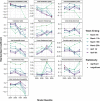The socio-spatial determinants of COVID-19 diffusion: the impact of globalisation, settlement characteristics and population
- PMID: 34016145
- PMCID: PMC8135172
- DOI: 10.1186/s12992-021-00707-2
The socio-spatial determinants of COVID-19 diffusion: the impact of globalisation, settlement characteristics and population
Abstract
Background: COVID-19 is an emergent infectious disease that has spread geographically to become a global pandemic. While much research focuses on the epidemiological and virological aspects of COVID-19 transmission, there remains an important gap in knowledge regarding the drivers of geographical diffusion between places, in particular at the global scale. Here, we use quantile regression to model the roles of globalisation, human settlement and population characteristics as socio-spatial determinants of reported COVID-19 diffusion over a six-week period in March and April 2020. Our exploratory analysis is based on reported COVID-19 data published by Johns Hopkins University which, despite its limitations, serves as the best repository of reported COVID-19 cases across nations.
Results: The quantile regression model suggests that globalisation, settlement, and population characteristics related to high human mobility and interaction predict reported disease diffusion. Human development level (HDI) and total population predict COVID-19 diffusion in countries with a high number of total reported cases (per million) whereas larger household size, older populations, and globalisation tied to human interaction predict COVID-19 diffusion in countries with a low number of total reported cases (per million). Population density, and population characteristics such as total population, older populations, and household size are strong predictors in early weeks but have a muted impact over time on reported COVID-19 diffusion. In contrast, the impacts of interpersonal and trade globalisation are enhanced over time, indicating that human mobility may best explain sustained disease diffusion.
Conclusions: Model results confirm that globalisation, settlement and population characteristics, and variables tied to high human mobility lead to greater reported disease diffusion. These outcomes serve to inform suppression strategies, particularly as they are related to anticipated relocation diffusion from more- to less-developed countries and regions, and hierarchical diffusion from countries with higher population and density. It is likely that many of these processes are replicated at smaller geographical scales both within countries and within regions. Epidemiological strategies must therefore be tailored according to human mobility patterns, as well as countries' settlement and population characteristics. We suggest that limiting human mobility to the greatest extent practical will best restrain COVID-19 diffusion, which in the absence of widespread vaccination may be one of the best lines of epidemiological defense.
Keywords: COVID-19; Coronavirus; Globalisation; Quantile regression; Spatial diffusion; Urbanisation.
Conflict of interest statement
The authors declare that they have no competing interests.
Figures




Similar articles
-
International trade as critical parameter of COVID-19 spread that outclasses demographic, economic, environmental, and pollution factors.Environ Res. 2021 Oct;201:111514. doi: 10.1016/j.envres.2021.111514. Epub 2021 Jun 15. Environ Res. 2021. PMID: 34139222 Free PMC article.
-
How does globalization affect COVID-19 responses?Global Health. 2021 May 20;17(1):57. doi: 10.1186/s12992-021-00677-5. Global Health. 2021. PMID: 34016146 Free PMC article.
-
International travel-related control measures to contain the COVID-19 pandemic: a rapid review.Cochrane Database Syst Rev. 2021 Mar 25;3(3):CD013717. doi: 10.1002/14651858.CD013717.pub2. Cochrane Database Syst Rev. 2021. PMID: 33763851 Free PMC article.
-
Globalisation in the time of COVID-19: repositioning Africa to meet the immediate and remote challenges.Global Health. 2020 Jun 24;16(1):51. doi: 10.1186/s12992-020-00581-4. Global Health. 2020. PMID: 32580728 Free PMC article.
-
Travel-related control measures to contain the COVID-19 pandemic: a rapid review.Cochrane Database Syst Rev. 2020 Oct 5;10:CD013717. doi: 10.1002/14651858.CD013717. Cochrane Database Syst Rev. 2020. Update in: Cochrane Database Syst Rev. 2021 Mar 25;3:CD013717. doi: 10.1002/14651858.CD013717.pub2. PMID: 33502002 Updated.
Cited by
-
A spatial-temporal analysis at the early stages of the COVID-19 pandemic and its determinants: The case of Recife neighborhoods, Brazil.PLoS One. 2022 May 17;17(5):e0268538. doi: 10.1371/journal.pone.0268538. eCollection 2022. PLoS One. 2022. PMID: 35580093 Free PMC article.
-
Comparison of Different Waves during the COVID-19 Pandemic: Retrospective Descriptive Study in Thailand.Adv Prev Med. 2021 Oct 8;2021:5807056. doi: 10.1155/2021/5807056. eCollection 2021. Adv Prev Med. 2021. PMID: 34659835 Free PMC article.
-
Ecosystem degradation and the spread of Covid-19.Environ Monit Assess. 2023 Jun 13;195(7):836. doi: 10.1007/s10661-023-11403-6. Environ Monit Assess. 2023. PMID: 37308607 Free PMC article. Review.
-
Intervention of Physical Activity for University Students with Anxiety and Depression during the COVID-19 Pandemic Prevention and Control Period: A Systematic Review and Meta-Analysis.Int J Environ Res Public Health. 2022 Nov 20;19(22):15338. doi: 10.3390/ijerph192215338. Int J Environ Res Public Health. 2022. PMID: 36430056 Free PMC article.
-
The implications of globalization on COVID-19 vaccination in Europe.Sci Rep. 2022 Oct 19;12(1):17474. doi: 10.1038/s41598-022-21493-w. Sci Rep. 2022. PMID: 36261454 Free PMC article.
References
-
- Wu F, Zhao S, Yu B, Chen YM, Wang W, Song ZG, Hu Y, Tao ZW, Tian JH, Pei YY, Yuan ML, Zhang YL, Dai FH, Liu Y, Wang QM, Zheng JJ, Xu L, Holmes EC, Zhang YZ. A new coronavirus associated with human respiratory disease in China. Nature. 2020;579(7798):265–269. doi: 10.1038/s41586-020-2008-3. - DOI - PMC - PubMed
-
- Harvey D. The condition of postmodernity. Oxford: Blackwell; 1989.
-
- Castells M. The rise of the network society. Sussex: Wiley; 2011.
-
- Ali SH, Keil R. Global cities and the spread of infectious disease: the case of severe acute respiratory syndrome (SARS) in Toronto, Canada. Urban Stud. 2006;43(3):491–509. doi: 10.1080/00420980500452458. - DOI
MeSH terms
LinkOut - more resources
Full Text Sources
Other Literature Sources
Medical
Miscellaneous

